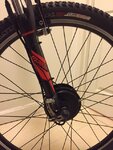WilliamT
Active Member
I just recently got my Dillenger 36v e-bike kit and hooked it up to a xs small Specialized Hardrock. Because the frame was too small to hold the battery, I bought a Topeak Explorer rack and the Topeak MTX EX bag. The battery was too big by 2-3 inches so I cut out the back of the bag so some of the battery is in the compartment that holds the water bottle in the back. The battery lays sideways in the bag and there is a hole we cut up front for the wires to go through. The power button can be reached outside the bag in the water bottle net so the bag can remain zipped up. There is also room to put repair kits and other things as well.
The front motor is pretty small so it not too noticeable. The wheel fit without any filing.
I still have to put the pedal sensor on and the magnets for disabling the motor when braking. Other than that it wasn't too hard to put together even without instructions.
The bike was initially 31.5 lbs. With the kit, bag, and rack the total weight came out to be 48.6 lbs.
The only problem that the main cable from the hub needs to be fully pushed in to the point where the arrow on the small connector has to pretty much touch the edge of the cable that goes to the battery. Just hearing it click isn't enough otherwise you get a error on the screen.
I did a quick ride on the bike using the throttle and its really moves. I'm happy with the results.
Here is the kit if anyone is interested.
http://dillengerelectricbikes.com/e...bike-kit-samsung-power-13ah-by-dillenger.html
Just used a box cutter to cut enough space for the battery. Its a snug fit and I have to turn it at a diagonal to remove and insert it. Other than that, it well padded. There is still some room for a repair kit, tire levers, and a tube next to the battery. On top of the battery there is still 11 in x 7 in x 2 in (LxWxH) of room; just enough for my U lock. The hole in the front for the wires and the rear should provide some ventilation for the battery. I'm not sure if I need to add more holes though.




The front motor is pretty small so it not too noticeable. The wheel fit without any filing.
I still have to put the pedal sensor on and the magnets for disabling the motor when braking. Other than that it wasn't too hard to put together even without instructions.
The bike was initially 31.5 lbs. With the kit, bag, and rack the total weight came out to be 48.6 lbs.
The only problem that the main cable from the hub needs to be fully pushed in to the point where the arrow on the small connector has to pretty much touch the edge of the cable that goes to the battery. Just hearing it click isn't enough otherwise you get a error on the screen.
I did a quick ride on the bike using the throttle and its really moves. I'm happy with the results.
Here is the kit if anyone is interested.
http://dillengerelectricbikes.com/e...bike-kit-samsung-power-13ah-by-dillenger.html
Just used a box cutter to cut enough space for the battery. Its a snug fit and I have to turn it at a diagonal to remove and insert it. Other than that, it well padded. There is still some room for a repair kit, tire levers, and a tube next to the battery. On top of the battery there is still 11 in x 7 in x 2 in (LxWxH) of room; just enough for my U lock. The hole in the front for the wires and the rear should provide some ventilation for the battery. I'm not sure if I need to add more holes though.




Last edited:


